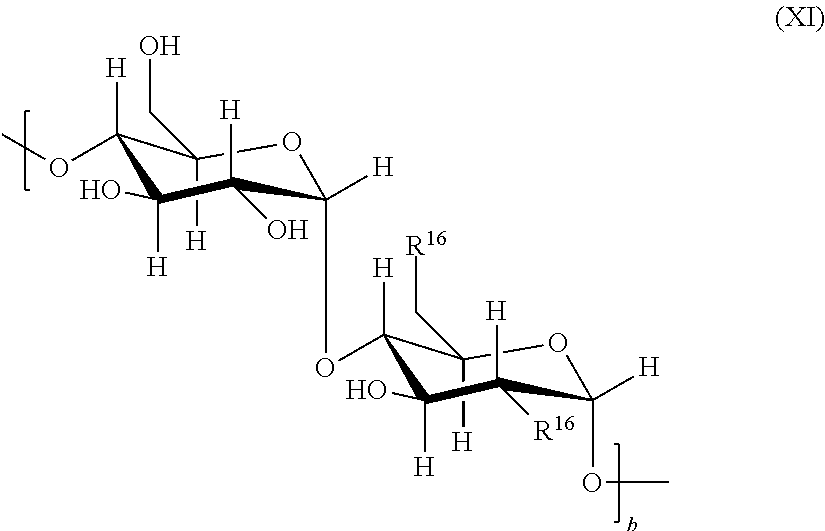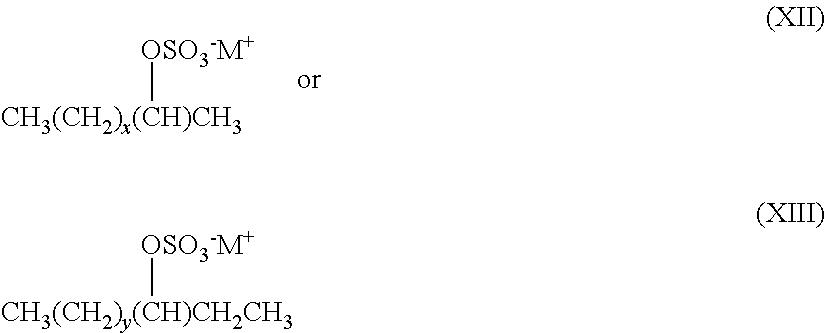Fabric care formulations and methods
a technology of fabric care and formulation, applied in the field of fabric care composition, can solve the problems of ruined garments, difficult and time-consuming stain removal process, and many products that do not achieve complete removal of greasy/oily stains, etc., and achieve the effect of improving stain repellency
- Summary
- Abstract
- Description
- Claims
- Application Information
AI Technical Summary
Benefits of technology
Problems solved by technology
Method used
Image
Examples
examples
1) Emulsion Preparation-Emulsion Mixtures
1.1. Preparation of a Stable Oil Mixture
[0156]13.2 g of MQ silicone resin ({[Me3SiO1 / 2]0.373[SiO2]0.627}40, Mn=2700 g / mol, resin contains appr. 0.2% OH and 3.1% OEt [corresponds to R10]) are dissolved in 10.5 g of ethylene glycol monohexyl ether (obtainable from Sigma-Aldrich Chemie GmbH) by stifling and subsequently admixed with 76.3 g of amine oil (viscosity about 1000 mm2 / s at 25° C. [corresponds to Ia+Ib+II+III=230], functional radicals —(CH2)3NH(CH2)NH2 [corresponds to R2], amine number of 0.6 mmol / g, 90 mol % SiMe3 end groups, 10 mol % SiMe2OH end groups [corresponds to II / III=9.0]) at 25° C. to obtain a clear, colorless solution having a viscosity of about 3000 mPa·s. This mixture is stable for a period of 3 months.
1.2. Preparation of a Stable Oil Mixture
[0157]13.2 g of MQ silicone resin ({[Me3SiO1 / 2]0.373[SiO2]0.627}40, Mn=2700 g / mol, resin contains appr. 0.2% OH and 3.1% OEt [corresponds to R10]) are dissolved in 10.5 g of ethylene g...
example 6
Liquid Detergent Compositions
[0177]The treatment or cleaning compositions herein, such as, but not limited to liquid detergent compositions, may take the form of an aqueous solution or uniform dispersion or suspension of surfactant and water, aqueous polyorganosiloxane-silicone resin mixture, and certain optional adjunct ingredients, some of which may normally be in solid form, that have been combined with the normally liquid components of the composition. Suitable surfactants may be anionic, nonionic, cationic, zwitterionic and / or amphoteric surfactants. In one embodiment, the cleaning composition comprises anionic surfactant, nonionic surfactant, or mixtures thereof.
[0178]Suitable anionic surfactants may be any of the conventional anionic surfactant types typically used in cleaning compositions, such as liquid or solid detergent products. Such surfactants include the alkyl benzene sulfonic acids and their salts as well as alkoxylated or non-alkoxylated alkyl sulfate materials. Exe...
example 7
Granular Laundry Detergent Compositions
[0194]In another aspect of the present disclosure, the fabric care compositions disclosed herein, may take the form of granular laundry detergent compositions. Such compositions comprise the dispersant polymer of the present disclosure to provide soil and stain removal and anti-redeposition, suds boosting, and / or soil release benefits to fabric washed in a solution containing the detergent. Typically, the granular laundry detergent compositions are used in washing solutions at a level of from about 0.0001% to about 0.05%, or even from about 0.001% to about 0.01% by weight of the washing solution.
[0195]Detergent compositions may be in the form of a granule. Typical components of granular detergent compositions include but are not limited to surfactants, builders, bleaches, bleach activators and / or other bleach catalysts and / or boosters, enzymes, enzyme stabilizing agents, soil suspending agents, soil release agents, pH adjusting agents and / or ot...
PUM
| Property | Measurement | Unit |
|---|---|---|
| particle size | aaaaa | aaaaa |
| particle size | aaaaa | aaaaa |
| particle size | aaaaa | aaaaa |
Abstract
Description
Claims
Application Information
 Login to View More
Login to View More - R&D
- Intellectual Property
- Life Sciences
- Materials
- Tech Scout
- Unparalleled Data Quality
- Higher Quality Content
- 60% Fewer Hallucinations
Browse by: Latest US Patents, China's latest patents, Technical Efficacy Thesaurus, Application Domain, Technology Topic, Popular Technical Reports.
© 2025 PatSnap. All rights reserved.Legal|Privacy policy|Modern Slavery Act Transparency Statement|Sitemap|About US| Contact US: help@patsnap.com



